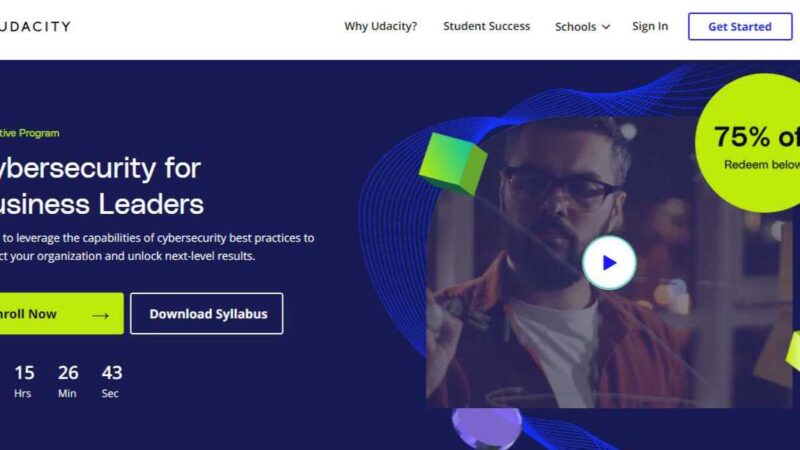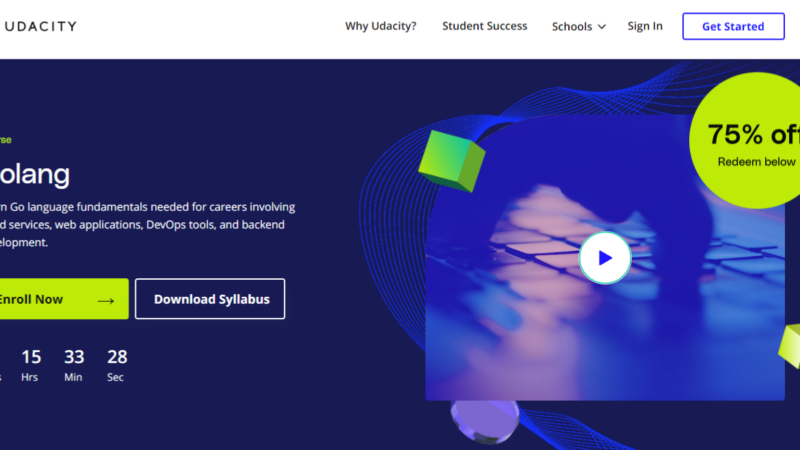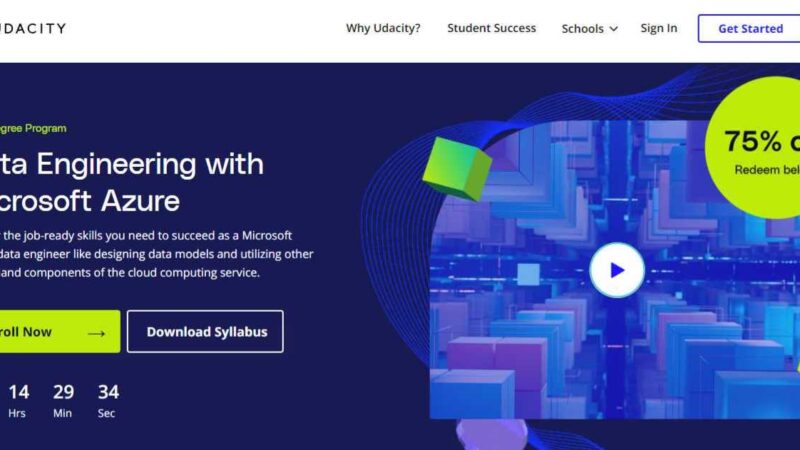Udacity Intro to Machine Learning with TensorFlow Review

Machine learning is a hot career that works hand in hand with today’s advanced technologies. Using algorithms and advanced machine learning techniques, machine learning engineers can create new and improved technologies that will help to evolve tomorrow’s gadgets. If this sounds like an interesting career, you’re taking the first step in the right direction to land your first gig! With a solid foundation in advanced machine learning techniques, you’ll be a competitive candidate for jobs with today’s hottest industry leaders.
You can get that solid foundation with the Intro to Machine Learning with TensorFlow Nanodegree from Udacity. This in-depth course comes with all that you’ll need to get your foot into the door. It was created in collaboration with AWS and Kaggle, packed with great information, hands-on projects, and taught by a team of A-list instructors. To learn a little bit more about this nanodegree and what it’s all about, check out our Intro to Machine Learning with TensorFlow review. You’ll find quotes from previous learners, a breakdown of the course, and a low down on the costs. Before we go there, let’s first take a look at Udacity and its nanodegrees.
About Udacity
Udacity is one of the top online learning platforms on the world wide web. They focus on everything IT, providing video lectures and in-depth courses. They came about over a decade ago, created with the idea to bring education to learners on the web. Now, they have certification courses developed with some of the top names in the industry and former students sprinkled all about. One of the most cherished items Udacity offers is their Nanodegree-a short and to the point course with lots of juicy perks.
What’s a Nanodegree?
A nanodegree by definition is a course that takes only a few months to complete. With Udacity, they take it a step above, adding lots of extras that learners are sure to enjoy. Nanodegrees from Udacity hone in on one area of IT, taking learners on an in-depth journey through all the skills they will need to step into the industry. Apart from a killer curriculum, each nanodegree from Udacity comes with:
- The ability to learn at your own pace
- In-depth curriculum with real industry projects
- A personal mentor to help keep you on track
- Access to a community of learners just like you
- Career prep including mock interviews and resume cleanup
- A-List instructors that you’ll only find at Udacity
Meet your Instructors
Udacity goes above and beyond on their hunt for instructors. For each course, you are led by some of the hottest employs and instructors in the business. For the Intro to Machine Learning with TensorFlow Nanodegree, your instructors are:
Cezanne Camacho
Cezanne has a master’s in Electrical Engineering from Stanford University. She’s worked with everything from genomics to machine learning and more, gaining most of her industry experience in the medical field. She is the curriculum lead for this course and gives great advice about how to apply knowledge learned in the real world.
Mat Leonard
Mat’s background in physics gives him a different outlook on how to apply knowledge to machine learning. He’s got experience working as a data scientist and as a neuroscientist, bringing about a unique and multi-faceted angle to the industry.
Luis Serrano
Luis worked with top name Google for years as a Machine Learning Engineer. His time in the field was preceded by studies at the University of Michigan, where he received his Ph.D. in mathematics. Luis has years of industry experience plus a passion for education.
Dan Romuald
Dan is a Business Developer at Amazon for all things Machine Learning. He has a business mindset that adds a different perspective to the field, working with every size of business from startups and beyond.
Jennifer Staab
Jennifer is an expert in Computer Science. During her time in the field, she has worked as a statistician with United Therapeutics and RTI International. On top of that, she loves to share her knowledge, teaching for both Udacity and Florida Polytechnic University.
Sean Carrell
Sean holds a Ph.D. in mathematics and is an expert with Algebraic Combinatorics. His advanced understanding of mathematics and how algorithms power machines are super helpful throughout the course, as he helps you understand how it applies to the field in real life.
Course Breakdown
This is an intro course so you’re introduced to all the fundamental algorithms you’ll need for machine learning. Starting with supervised models, you’ll get a good grasp on initial concepts, taking your knowledge further in-depth as the course progresses. Each of the three lessons comes with a project tacked onto the end, setting you free to practice what you learned in the sections before.
Prerequisites
Though this is an introductory course, it is meant for those who have experience with Python. Those who are ready to take the course should also be comfortable with mathematical models and statistical concepts.
Supervised Learning
Right from the start, you’ll move into supervised learning. You’ll learn about model construction and see how to apply algorithms and statistical models.
Project! Find Donors for Charity
You’ll work with a simulated charity-Charity ML, helping them to get the highest number of donations. Work with supervised learning techniques to evaluate and optimize the charity’s probability of getting higher donations.
Deep Learning
Now it’s time to work with TensorFlow. In this section, you’ll learn all the inner workings of TensorFlow, using it to build and design complex and advanced neural networks.
Project! Build an Image Classifier
Using a deep learning model, you’ll work to classify images. You’ll work with Jupyter Notebook to develop your idea then translate it to Python. This will help you when writing the correct command line in your system.
Unsupervised Learning
Problem domains are alive and very real. You’ll work with these, learning which methods and unsupervised learning models you can use to help.
Project! Create Customer Segments
Using the techniques you learned in the last section, you’ll use unsupervised learning techniques to compare and contrast a set of customers. Work with the concepts of clustering and categorizing data, learning how you can make readable graphs from large sets of data.
How Long Does the Course Take?
One of the Udacity Nanodegree perks is that you can learn at your own pace. That being said, you can take as long as you would like just as long as you keep up with due dates on projects. For an estimate, Udacity claims that this course takes about 3 months when you dedicate just 10 hours a week. Whether you have more time or less time, you can decide, taking advantage of a relaxed learning schedule. However, before you take too long, you might want to keep the cost in mind, as it adds up the longer you take.
How Much Does the Course Cost?
We might have left you with a few questions from that last sentence. What we mean is that Udacity offers two ways to pay, each coming with their charm. The best thing to do is think about how much time you have to dedicate to the course, using that to help you make your decision and save some dough at the end. Let’s take a look at each option-helping you decide which way you want to pay.
Pay as you go
When you pay as you go, you’re able to take as long as you like. Though you will need to turn in your projects on time, you won’t have to worry about finishing the lectures by a certain date. This is a great option for those that have more time to dedicate to the program, perhaps saving a bit of money in the long run. Each month of access costs $359, which could add up if you take too long.
Udacity’s bundle and save deal
You also have the option to bundle and save. Udacity uses their estimated time for course completion to put together a deal and knock 15% off. This option gives you three months off access to the course for $927. This is a better option if you agree with Udacity’s estimate. If not, you’re better off trying to finish faster and save a few bucks while you’re at it.
What Have Learners Said?
It’s good to know what others have said about the course. Overall, it has a rating of 4.7 out of 5, and here’s what a few learners had to say.
“Thanks, it’s going well, I really love the instructor, Luis he talks about these concepts so “matter of fact” which makes it believable and understandable. Plus the graphics are great like “Mount Errorest” and the mountain climber when describing “gradient descent”. The first project was a lot of template code and I felt badly like I didn’t accomplish it on my own however, it was enough to get us started so we have a good foundation once we move on past this Nanodegree, and in the future we’ll be able to build our own templates. I think the template code is necessary such that we have a solid base of how to conduct our testing and training, etc. As opposed to scanning Stack Overflow, etc.” – Mariam J.
“It’s for sure taught me a ton about the nature of supervised learning and all the things that go along with it. It’s really cool to be able to understand all these things about machine learning that I never really knew before. I’ll admit, when I started this program, I didn’t really have a lot of motivation. I mean, I wanted to do it cause ML is kind of a big deal now, but I wasn’t super motivated to get through the harder content. But now, just with the simpler explanations and easy-going environment, I’ve for sure found motivation even just in that! And I can use this for what I’m doing at work, so that’s a huge bonus.” – Luke H.
“I really like this program! It explains concepts in very simple and well-visualized ways that make them easy to grasp and the quizzes are pretty effective. I come out of a video thinking I got the concept, then get stuck on a quiz for 10 mins and realize I’ve missed details.” – Michelle C.
What’s the Job Market Like?
In the year 2020, we are all left wondering what’s going to happen. When Covid-19 swept the world, the necessity to be online skyrocketed, with more people working from home than ever before. There are several industries that we are unsure of but, one that will surely continue and thrive is IT. As the world becomes more advanced with techniques, strategies, and technologies, we have more opportunities to work with evolved machine learning.
Starting in the year 2019, there was actually a shortage of experts in machine learning. This crept into the year 2020, and is now larger than before, with plenty of opportunities for those with advanced skills needed to power the technology of tomorrow. Tie that in with knowledge of Python, one of the most used advanced programming languages, and you’ve got an equation for success, sure to find a job in no time.
No Day but Today
If you’ve ever thought about breaking into the exciting world of machine learning, now is a better time than ever. With a shortage in the field and the demand growing daily, you’re sure to have a career in no time. Udacity is a great choice when it comes to scoring the skills needed to break into the industry, especially with their extras that come with each nanodegree. When you sign up you’ll get:
- To take your time
- Enjoy career services
- To land a job quickly
The world of advanced technology is among us and most of it is thanks to advanced algorithms and complex machine learning techniques. To get your foot in the door, you’ll need a solid foundation, one that you can get with you take the Intro to Machine Learning with TensorFlow Nanodegree with Udacity.
Get Flat 65% with our exclusive link, Claim Now





